turn signal KIA QUORIS 2015 Owners Manual
[x] Cancel search | Manufacturer: KIA, Model Year: 2015, Model line: QUORIS, Model: KIA QUORIS 2015Pages: 486, PDF Size: 35.55 MB
Page 14 of 486
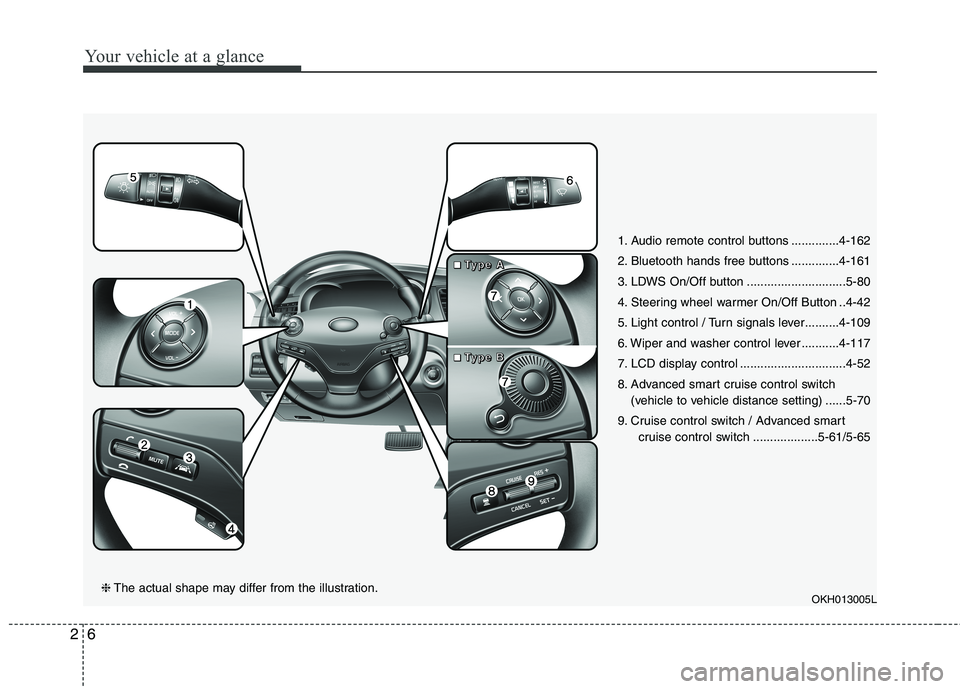
Your vehicle at a glance
6
2
1. Audio remote control buttons ..............4-162
2. Bluetooth hands free buttons ..............4-161
3. LDWS On/Off button .............................5-80
4. Steering wheel warmer On/Off Button ..4-42
5. Light control / Turn signals lever..........4-109
6. Wiper and washer control lever ...........4-117
7. LCD display control ...............................4-52
8. Advanced smart cruise control switch
(vehicle to vehicle distance setting) ......5-70
9. Cruise control switch / Advanced smart cruise control switch ...................5-61/5-65
OKH013005L
❈The actual shape may differ from the illustration.
■■■■TTTTyyyyppppeeee AAAA
■■■■TTTTyyyyppppeeee BBBB
Page 61 of 486
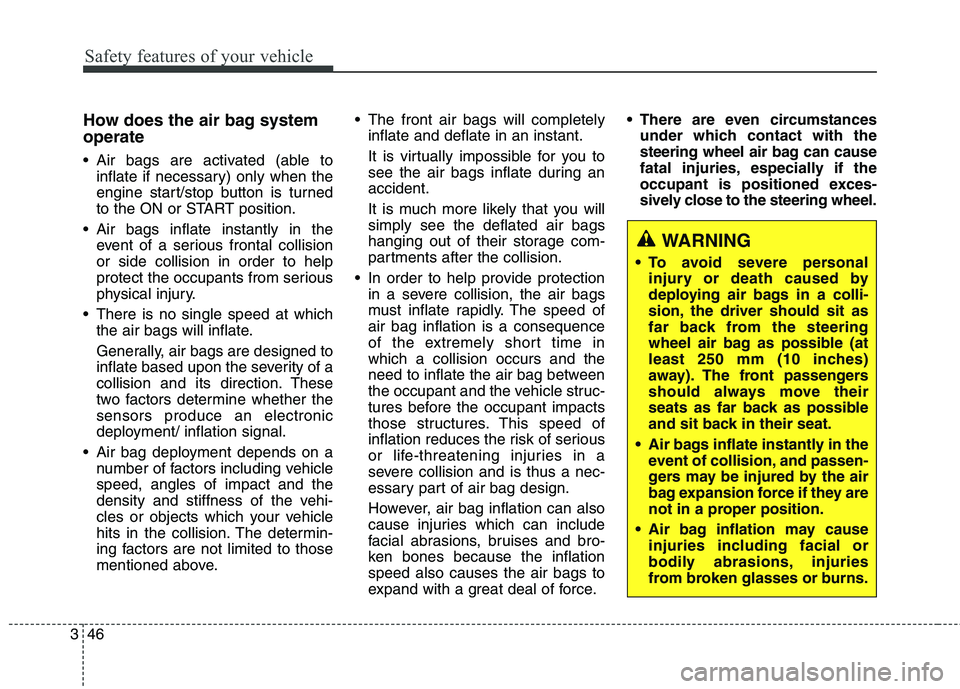
Safety features of your vehicle
46
3
How does the air bag system operate
Air bags are activated (able to
inflate if necessary) only when the
engine start/stop button is turned
to the ON or START position.
Air bags inflate instantly in the event of a serious frontal collisionor side collision in order to help
protect the occupants from serious
physical injury.
There is no single speed at which the air bags will inflate.
Generally, air bags are designed to
inflate based upon the severity of a
collision and its direction. These
two factors determine whether thesensors produce an electronic
deployment/ inflation signal.
Air bag deployment depends on a number of factors including vehiclespeed, angles of impact and the
density and stiffness of the vehi-
cles or objects which your vehicle
hits in the collision. The determin-
ing factors are not limited to those
mentioned above. The front air bags will completely
inflate and deflate in an instant.
It is virtually impossible for you to
see the air bags inflate during anaccident.
It is much more likely that you will simply see the deflated air bags
hanging out of their storage com-
partments after the collision.
In order to help provide protection in a severe collision, the air bags
must inflate rapidly. The speed ofair bag inflation is a consequence
of the extremely short time inwhich a collision occurs and the
need to inflate the air bag between
the occupant and the vehicle struc-
tures before the occupant impacts
those structures. This speed of
inflation reduces the risk of serious
or life-threatening injuries in a
severe collision and is thus a nec-
essary part of air bag design.
However, air bag inflation can also
cause injuries which can include
facial abrasions, bruises and bro-
ken bones because the inflationspeed also causes the air bags to
expand with a great deal of force. There are even circumstances
under which contact with the
steering wheel air bag can cause
fatal injuries, especially if the
occupant is positioned exces-
sively close to the steering wheel.
WARNING
To avoid severe personal injury or death caused by
deploying air bags in a colli-
sion, the driver should sit as
far back from the steering
wheel air bag as possible (at
least 250 mm (10 inches)
away). The front passengers
should always move their
seats as far back as possible
and sit back in their seat.
Air bags inflate instantly in the event of collision, and passen-
gers may be injured by the air
bag expansion force if they are
not in a proper position.
Air bag inflation may cause injuries including facial or
bodily abrasions, injuries
from broken glasses or burns.
Page 145 of 486
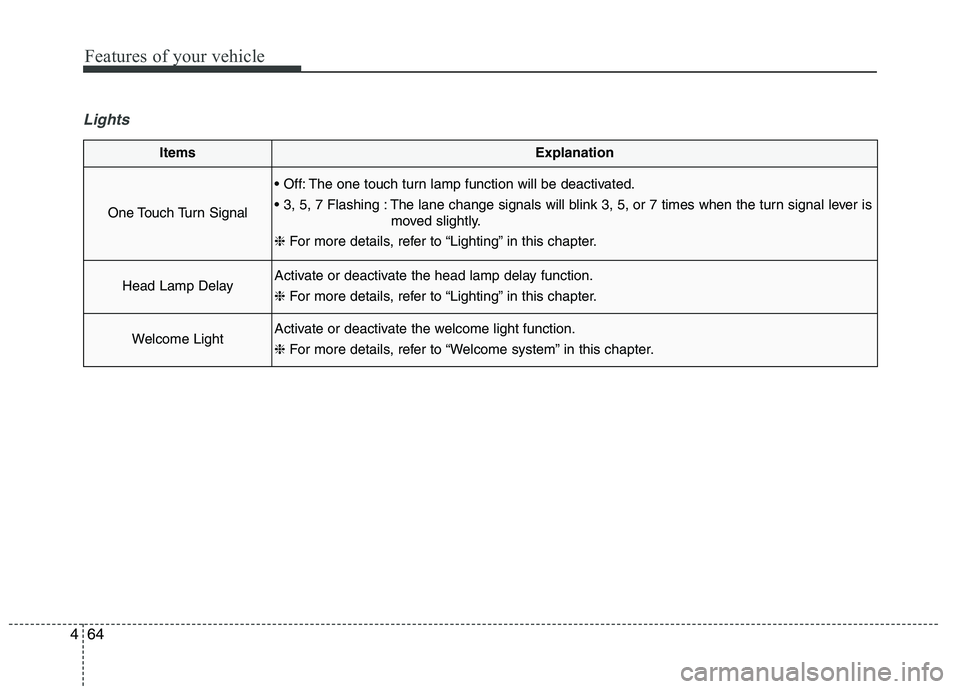
Features of your vehicle
64
4
Lights
ItemsExplanation
One Touch Turn Signal
The one touch turn lamp function will be deactivated.
The lane change signals will blink 3, 5, or 7 times when the turn signal lever is
moved slightly.
❈ For more details, refer to “Lighting” in this chapter.
Head Lamp DelayActivate or deactivate the head lamp delay function. ❈ For more details, refer to “Lighting” in this chapter.
Welcome LightActivate or deactivate the welcome light function. ❈ For more details, refer to “Welcome system” in this chapter.
Page 172 of 486
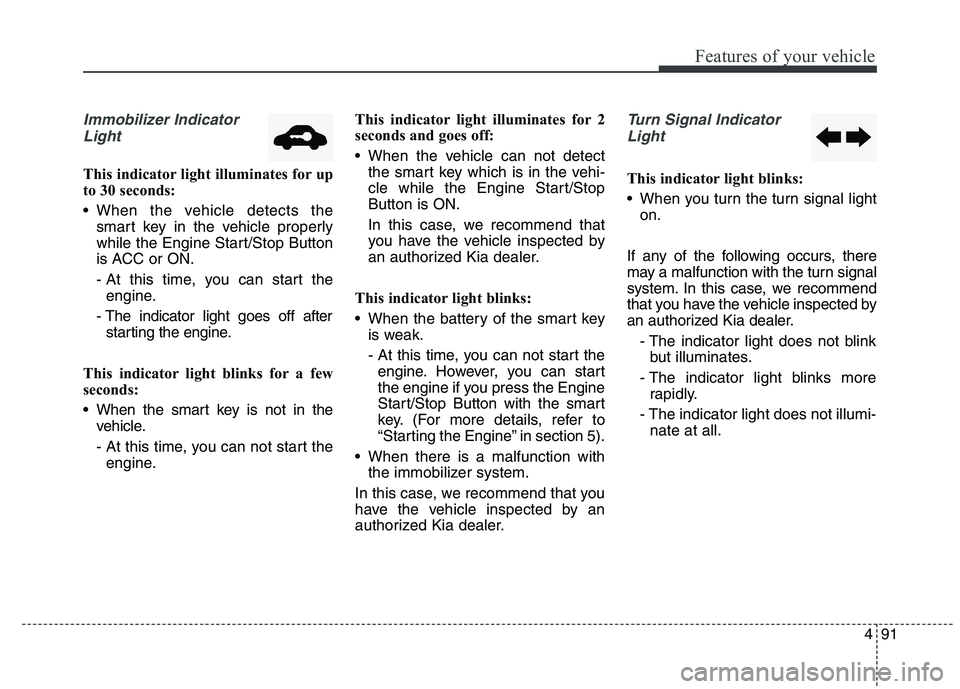
491
Features of your vehicle
Immobilizer IndicatorLight
This indicator light illuminates for up
to 30 seconds:
When the vehicle detects the smart key in the vehicle properly
while the Engine Start/Stop Button
is ACC or ON.
- At this time, you can start theengine.
- The indicator light goes off after starting the engine.
This indicator light blinks for a few
seconds:
When the smart key is not in the vehicle.
- At this time, you can not start theengine. This indicator light illuminates for 2
seconds and goes off:
When the vehicle can not detect
the smart key which is in the vehi-
cle while the Engine Start/StopButton is ON.
In this case, we recommend that
you have the vehicle inspected by
an authorized Kia dealer.
This indicator light blinks:
When the battery of the smart key is weak.
- At this time, you can not start theengine. However, you can start
the engine if you press the Engine
Start/Stop Button with the smart
key. (For more details, refer to
“Starting the Engine” in section 5).
When there is a malfunction with the immobilizer system.
In this case, we recommend that you
have the vehicle inspected by an
authorized Kia dealer.
Turn Signal Indicator Light
This indicator light blinks:
When you turn the turn signal light on.
If any of the following occurs, there
may a malfunction with the turn signal
system. In this case, we recommend
that you have the vehicle inspected by
an authorized Kia dealer. - The indicator light does not blinkbut illuminates.
- The indicator light blinks more rapidly.
- The indicator light does not illumi- nate at all.
Page 173 of 486
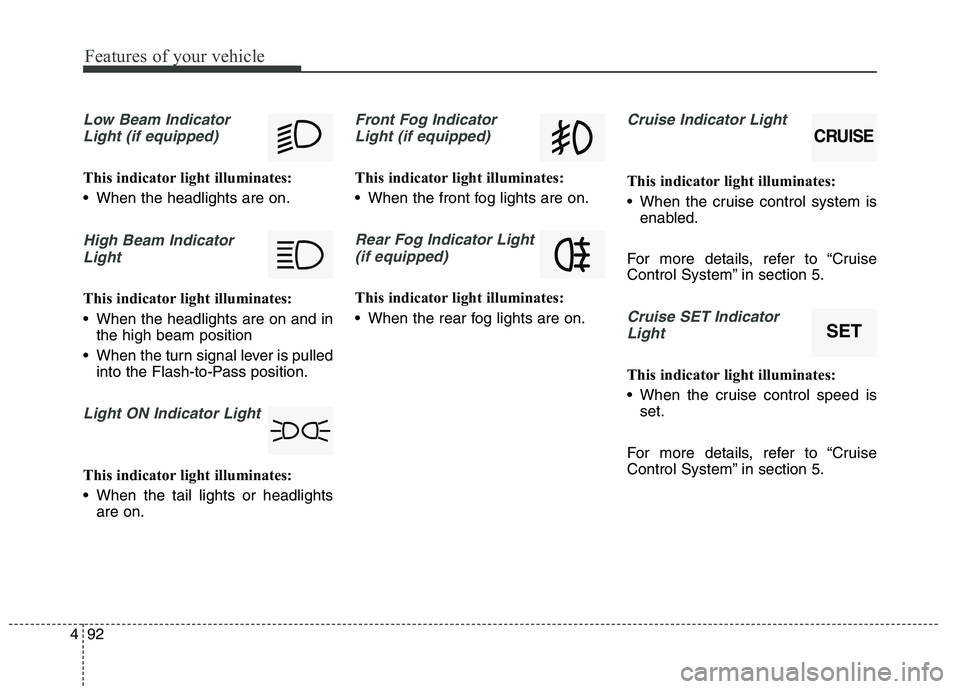
Features of your vehicle
92
4
Low Beam Indicator
Light (if equipped)
This indicator light illuminates:
When the headlights are on.
High Beam IndicatorLight
This indicator light illuminates:
When the headlights are on and in the high beam position
When the turn signal lever is pulled into the Flash-to-Pass position.
Light ON Indicator Light
This indicator light illuminates:
When the tail lights or headlightsare on.
Front Fog Indicator
Light (if equipped)
This indicator light illuminates:
When the front fog lights are on.
Rear Fog Indicator Light (if equipped)
This indicator light illuminates:
When the rear fog lights are on.
Cruise Indicator Light
This indicator light illuminates:
When the cruise control system is enabled.
For more details, refer to “Cruise
Control System” in section 5.
Cruise SET Indicator Light
This indicator light illuminates:
When the cruise control speed is set.
For more details, refer to “Cruise
Control System” in section 5.
CRUISE
SET
Page 194 of 486
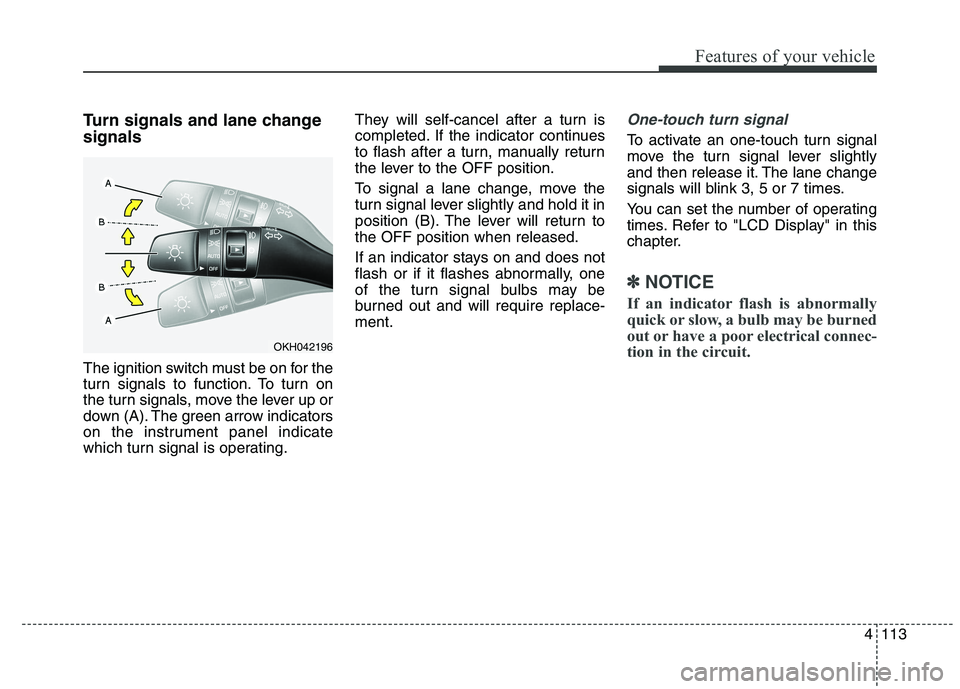
4113
Features of your vehicle
Turn signals and lane change signals
The ignition switch must be on for the
turn signals to function. To turn on
the turn signals, move the lever up or
down (A). The green arrow indicators
on the instrument panel indicate
which turn signal is operating.They will self-cancel after a turn is
completed. If the indicator continues
to flash after a turn, manually return
the lever to the OFF position.
To signal a lane change, move the
turn signal lever slightly and hold it in
position (B). The lever will return tothe OFF position when released.
If an indicator stays on and does not
flash or if it flashes abnormally, one
of the turn signal bulbs may be
burned out and will require replace-ment.One-touch turn signal
To activate an one-touch turn signal
move the turn signal lever slightly
and then release it. The lane change
signals will blink 3, 5 or 7 times.
You can set the number of operating
times. Refer to "LCD Display" in this
chapter.
✽✽
NOTICE
If an indicator flash is abnormally
quick or slow, a bulb may be burned
out or have a poor electrical connec-
tion in the circuit.
OKH042196
Page 242 of 486
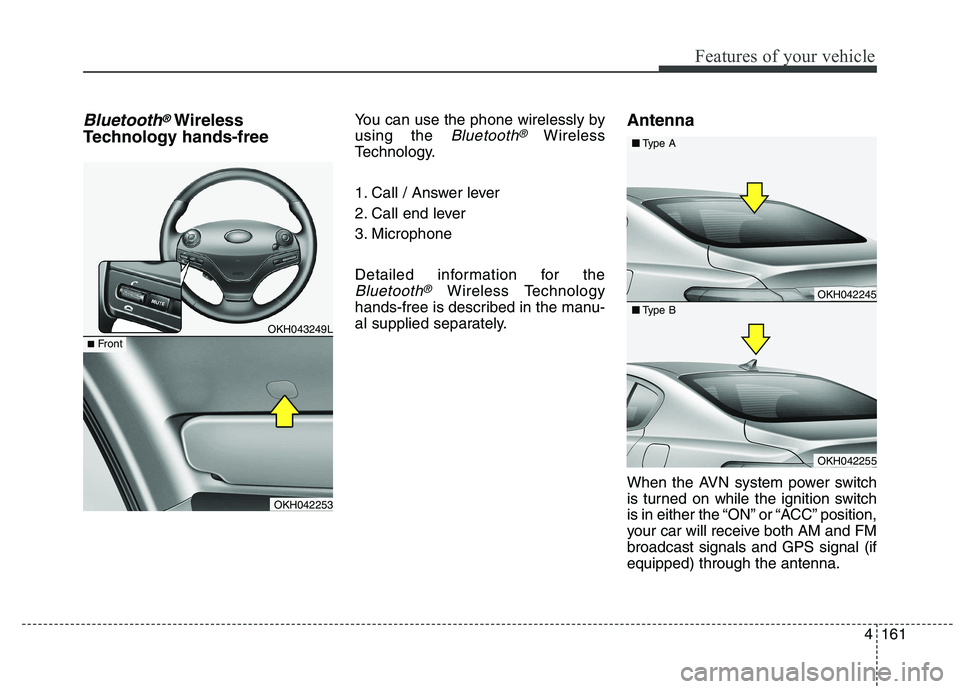
4161
Features of your vehicle
Bluetooth®Wireless
Technology hands-free You can use the phone wirelessly by using the Bluetooth®Wireless
Technology.
1. Call / Answer lever
2. Call end lever
3. Microphone
Detailed information for the
Bluetooth®Wireless Technology
hands-free is described in the manu-
al supplied separately. Antenna
When the AVN system power switch
is turned on while the ignition switch
is in either the “ON” or “ACC” position,
your car will receive both AM and FMbroadcast signals and GPS signal (ifequipped) through the antenna.OKH042245
OKH042255
■
Type A
■Type B
OKH043249L
OKH042253
■Front
Page 282 of 486
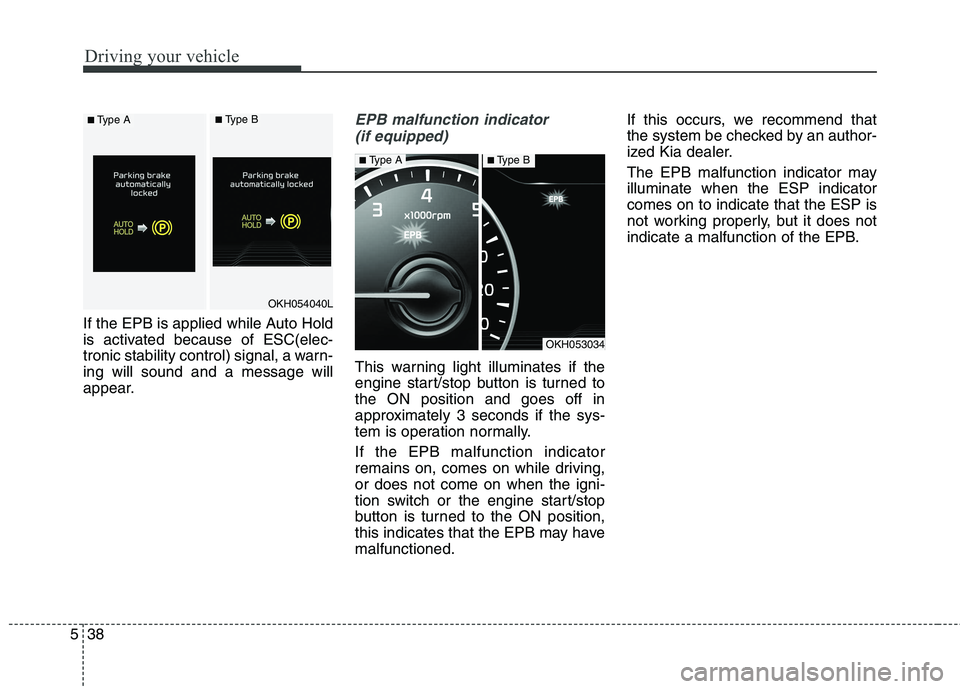
Driving your vehicle
38
5
If the EPB is applied while Auto Hold
is activated because of ESC(elec-
tronic stability control) signal, a warn-ing will sound and a message will
appear.
EPB malfunction indicator
(if equipped)
This warning light illuminates if the
engine start/stop button is turned tothe ON position and goes off in
approximately 3 seconds if the sys-
tem is operation normally. If the EPB malfunction indicator
remains on, comes on while driving,or does not come on when the igni-
tion switch or the engine start/stop
button is turned to the ON position,
this indicates that the EPB may havemalfunctioned. If this occurs, we recommend that
the system be checked by an author-
ized Kia dealer.
The EPB malfunction indicator may illuminate when the ESP indicatorcomes on to indicate that the ESP is
not working properly, but it does not
indicate a malfunction of the EPB.
OKH054040L
■
Type A■Type B
OKH053034
■Type A■Type B
Page 326 of 486
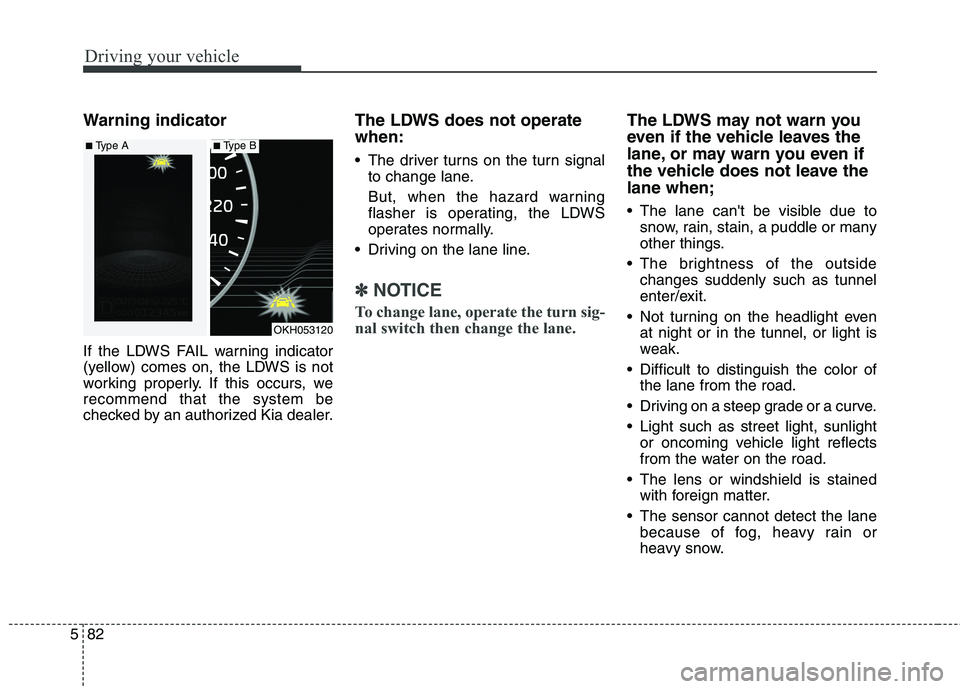
Driving your vehicle
82
5
Warning indicator
If the LDWS FAIL warning indicator
(yellow) comes on, the LDWS is not
working properly. If this occurs, werecommend that the system be
checked by an authorized Kia dealer. The LDWS does not operate when:
The driver turns on the turn signal
to change lane.
But, when the hazard warning
flasher is operating, the LDWS
operates normally.
Driving on the lane line.
✽✽ NOTICE
To change lane, operate the turn sig-
nal switch then change the lane.
The LDWS may not warn you
even if the vehicle leaves the
lane, or may warn you even if
the vehicle does not leave thelane when;
The lane can't be visible due to snow, rain, stain, a puddle or many
other things.
The brightness of the outside changes suddenly such as tunnel
enter/exit.
Not turning on the headlight even at night or in the tunnel, or light is
weak.
Difficult to distinguish the color of the lane from the road.
Driving on a steep grade or a curve.
Light such as street light, sunlight or oncoming vehicle light reflects
from the water on the road.
The lens or windshield is stained with foreign matter.
The sensor cannot detect the lane because of fog, heavy rain or
heavy snow.
OKH053120
■Type A■Type B
Page 330 of 486
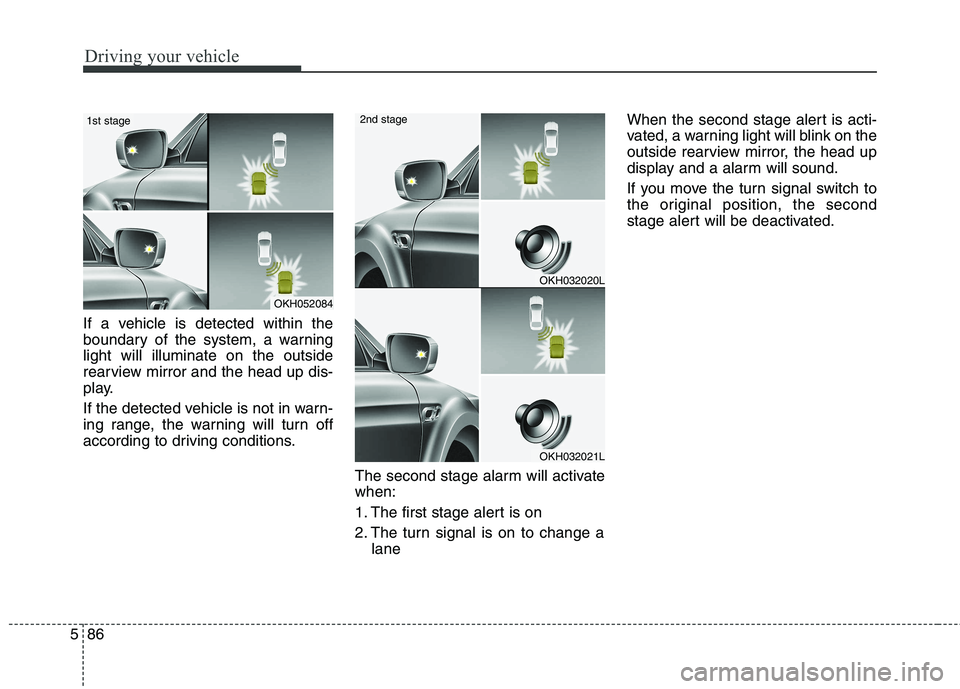
Driving your vehicle
86
5
If a vehicle is detected within the
boundary of the system, a warninglight will illuminate on the outside
rearview mirror and the head up dis-
play.
If the detected vehicle is not in warn-
ing range, the warning will turn off
according to driving conditions.
The second stage alarm will activatewhen:
1. The first stage alert is on
2. The turn signal is on to change alane When the second stage alert is acti-
vated, a warning light will blink on the
outside rearview mirror, the head up
display and a alarm will sound.
If you move the turn signal switch to
the original position, the second
stage alert will be deactivated.
OKH052084
1st stage
OKH032020L
OKH032021L
2nd stage